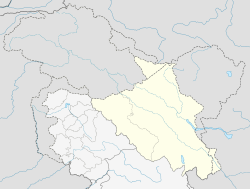Chalunka Chulungkha | |
|---|---|
Village | |
| Coordinates: 34°49′26″N76°56′06″E / 34.824°N 76.935°E | |
| Country | |
| Union territory | Ladakh |
| District | Leh |
| Tehsil | Nubra |
| Population (2011) | |
• Total | 516 |
| Time zone | UTC+5:30 (IST) |
| Census code | 914 |
Chalunka (also known as Chalunkha or Chulungkha) is a small mountainous village, in Nubra tehsil and Turtuk community development block, in Chorbat area of Shyok River valley in Ladakh, India. [1] [2] At the end of the Indo-Pakistani War of 1947, it was on the cease-fire line agreed between the India and Pakistan. [3] After the Indo-Pakistani War of 1971, the village came under the jurisdiction of Indian-administered Jammu & Kashmir.



